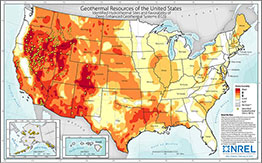Next-Generation Geothermal
NREL is advancing research to access geothermal heat anywhere in the world—even where fluid and fractures do not naturally exist.

Traditional hydrothermal systems—also called conventional geothermal resources—are found in places with three key ingredients: heat, natural fractures (permeability), and fluid. The natural fractures and fluid bring the heat to the surface, but the collocation of these three key ingredients is controlled by geology, restricting conventional geothermal resources to limited locations throughout the world.
Enhanced Geothermal Systems
Enhanced geothermal systems (EGS) provide tremendous opportunity for harvesting the vast, untapped heat stored in the shallow continental crust around the world. EGS technology facilitates the development of low-permeability geothermal resources. Unlike advanced geothermal systems, EGS requires augmentation of reservoir permeability using stimulation techniques that open pre-existing fractures or create new ones.
Recent advancements include applying oil and gas developed techniques such as long horizontal laterals and multi-stage hydraulic fracturing to geothermal settings. Recent and ongoing demonstrations (e.g., Fervo, FORGE, DOE EGS demonstrations) show successful creation of a fracture network in deep and hot impermeable rocks combined with long-term fluid circulation.
NREL is focusing on characterizing the subsurface to ensure accurate, onsite understanding of EGS to allow for optimization of fracture networks and strategic development and operational decisions. The other key area for such systems is in drilling analysis and techno-economic modeling to optimize deep drilling efficiencies, a critical step in developing EGS.
NREL is partnering with Cornell University to develop EGS reservoir models and run techno-economic simulations of utilizing EGS to provide heating to the university campus. NREL is also partnering with Utah FORGE to test innovative chemical stimulation concepts to enhance reservoir permeability. These chemical stimulation methods can be used by the global EGS community instead of, or in tandem with, mechanical stimulation methods.
Closed-Loop Geothermal
NREL's expertise in geothermal research and development, techno-economic modeling, power plant designs, data management and communications, and site operations is contributing to the advancement and commercial-scale deployment of closed-loop geothermal (CLG). A CLG system uses one or more wells drilled into hot rock with fluid circulating through a closed-loop system to bring heat to the surface for direct heating and electricity applications. Several CLG designs have been proposed based on different geometries and heat transfer fluids.
CLG can be attractive because:
- Heat production can be estimated with relatively high confidence
- Reservoir stimulation is not required, which limits the risk of induced seismicity and lowers water consumption
- It can theoretically be applied anywhere
- It is an engineered system and has opportunities for optimization and scale-up with technological improvements.
Challenges include potentially complex downhole completions and creating sufficient area for heat transfer with the surrounding rock. NREL is spearheading research in optimization solutions for these challenges.
Publications
Numerical Investigation of Closed-Loop Geothermal Systems In Deep Geothermal Reservoirs, Geothermics (2024)
Tabulated Database of Closed-Loop Geothermal Systems Performance for Cloud-Based Technical and Economic Modeling of Heat Production and Electricity Generation: Preprint, 48th Stanford Geothermal Workshop (2023)
Superhot Rock Geothermal
Electricity production through conventional geothermal power plant technologies—such as binary, flash, and dry steam systems—typically requires temperatures between 100°C and 350°C, encountered at depths of less than 3 km. However, higher enthalpy fluids have been encountered in geothermal wells, and where those fluids reach supercritical temperatures and pressures (>400 °C) the estimated energy output is up to 10 times that of a normal geothermal well. These types of “superhot rock” (SHR) systems have not yet been harnessed for power production due to significant technical and technological challenges. Understanding and producing SHR resources—whether naturally occurring or engineered through implementation of next-generation technologies in superhot rock settings—could greatly improve the economics of geothermal energy development. NREL is working with international consortia to advance characterization and reservoir engineering tools to de-risk SHR, and developing techno-economic tools for evaluating the full suite of geothermal technologies, including next-generation and hybrid systems, to optimize the use of these high-temperature resources. Additionally, NREL aims to leverage lab capabilities to address other technological challenges related to SHR development (advanced drilling methods, materials, reservoir monitoring etc.).
Featured Projects
Supercritical Geothermal Systems: DErisking Exploration for Geothermal Plays in Magmatic Environments
NREL is partnering with international research institutions on the Geothermica-funded DEEPEN project to de-risk geothermal exploration in deep, supercritical magmatic plays. The project is developing a play fairway methodology specific to magmatic plays that includes the roots zone of the geothermal system (supercritical fluids, magma bodies, the brittle-ductile transition zone, and other elements). The project is also focused on developing new tools to help with subsurface imaging of deep and hot bodies.
Impact
This project could increase the power output of geothermal plants tenfold, significantly improving geothermal project economics.
Partners
Equinor, Reykjavik Energy, ISOR, NORSAR, Lawrence Berkeley National Laboratory, and other international research institutions
Capabilities

Our high-quality data resources, tools, management solutions, and visualizations advance the use of geothermal energy.
Data Resources and Tools
Geothermal Data Repository
The Geothermal Data Repository enables research, collaboration, and transparency by providing universal access to geothermal data. It provides free access to data generated from projects funded by DOE's Geothermal Technologies Office to facilitate the open transfer of knowledge, fuel innovation, reduce duplication of effort, and promote scientific discovery in the geothermal sector. The GDR now includes data lakes to enhance accessibility of especially large or complex datasets through cloud-based access and automated data pipelines to automatically standardize high-value datasets, improving the availability of high-quality data.
Data Foundry
The Data Foundry provides secure, cloud-based storage and universal access to digital information to enable the geothermal industry to collaborate with the Department of Energy, national labs, universities, and private organizations.
Publications
De-Risking Superhot Enhanced Geothermal System Development Through 3D Play Fairway Analysis: Methodology Development and Application at Newberry Volcano, Oregon, USA, Geothermics, (2024)
Geothermal Play Fairway Analysis Best Practices, NREL Technical Report (2023)
Assessing Low-Temperature Geothermal Play Types: Relevant Data and Play Fairway Analysis Methods, NREL Technical Report (2023)
Low-Temperature Geothermal Geospatial Datasets: An Example From Alaska, NREL Conference Paper (2023)
The Data Foundry: Secure Collaboration for the Geothermal Industry, 45th Workshop on Geothermal Reservoir Engineering (2020)

We use the latest machine learning techniques, best practices, high-performance computing capabilities, and our geothermal expertise to create data-centric and physics-based tools to solve complex problems.
Advancements in machine learning and artificial intelligence are creating opportunities for innovation and optimization in the geothermal industry. NREL is continuously researching the best ways to derive insights from data using machine learning and artificial intelligence, with solutions ranging from simple regression models to deep learning, encompassing genetic algorithms, reinforcement learning, and more. NREL is keen on maximizing the quality of the data used in these experiments as a means to maximize the quality of results, implementing solutions like data curation pipelines, automated data standardization, and data augmentation through generative machine learning.
These techniques are used in combination with our expertise in geophysics, geology, drilling, power conversion, electricity generation, and thermodynamics to generate artificially intelligent, data-centric and physics-based tools capable of improving:
- Subterranean resource characterization
- Discrete microseismic event identification and characterization
- Advanced drilling fault detection and fault prediction
- Optimization of steam field operations.
These innovative tools, adherence to best practices, and attention to the quality of the training data improve the accuracy and efficiency of geothermal exploration, reduce the cost of geothermal exploration, and optimize geothermal operations—driving down the overall cost of geothermal energy.
Publications
Distributed Sensing and Machine Learning Hone Seismic Listening Article, Eos Transactions American Geophysical Union (2022)
Geothermal Operational Optimization with Machine Learning, World Geothermal Congress (2020)
A New Modeling Framework for Geothermal Operational Optimization with Machine Learning (GOOML), Energies (2021)
Using Machine Learning To Predict Future Temperature Outputs in Geothermal Systems, Transactions (2020)
Which Geologic Characteristics Control Porosity and Permeability in Hydrothermal Reservoirs?, Transactions (2020)

We develop novel methodologies and workflows that capture and integrate disparate subsurface data to better define geothermal resources.
We apply our broad research and industrial experience to innovative analysis and assessment of geothermal resources to support government and industry efforts to advance geothermal discovery, development, and energy production.
Subsurface characterization extends from the surface down through reservoirs and beyond to understand geothermal resources ranging from shallow heat exchange and storage reservoirs to deep zones of supercritical fluids at the base of the seismogenic crust. With focus ranging from regional to prospect scale and through all phases of exploration and development, we aim to improve characterization of the subsurface environment by developing novel methodologies and workflows that capture and integrate disparate and limited subsurface data.
Publications
A Novel Approach to Map Permeability Using Passive Seismic Emission Tomography, World Geothermal Congress (2020)
NREL Flatirons Campus Geothermal Opportunities Assessment: Proposed Contributions to Integrated Energy Systems at Scale, NREL Technical Report (2020)
Sedimentary Geothermal Feasibility Study, NREL Technical Report (2017)

We produce high-resolution maps of worldwide geothermal resource potential as well as a national mapping interface to interact with geospatial datasets useful for geothermal development. NREL researchers are also advancing resource characterizations for temperature at depth and EGS potential.
Resource Characterization
Understanding resources is key to geothermal development. Although it's the United States Geological Survey's mission to study the U.S. geothermal resource, NREL takes its studies further to understand the technical, economic, and market potential and demand for these resources. NREL geoscientists review and analyze the resource potential of nontraditional resources, including traditional hydrothermal resources, supercritical resources, sedimentary and coproduced geothermal resources, enhanced geothermal resources (EGS), advanced geothermal resources, direct use resources, and shallow earth resources for geothermal heat pump and storage applications.
Mapping
NREL's geospatial data science research uses geographic information systems (GIS) to produce maps, analyses, models, applications, and visualizations that inform energy planning and production. We address critical challenges through cutting-edge practices, offering a unique perspective of the geospatial context surrounding contemporary geothermal issues and solutions. NREL data and visualization scientists integrate complex data sets into digestible, usable maps available for download or for use in our interactive Geothermal Prospector tool.
Publications
Sedimentary Geothermal Resources in Nevada, Utah, Colorado, and Texas, NREL Technical Report (2020)
GeoRePORT Protocol Volume II: Geological Assessment Tool, NREL Technical Report (2019)
GeoVision Analysis Supporting Task Force Report: Thermal Applications, NREL Technical Report (2019)
Geothermal Resources of the United States: Identified Hydrothermal Sites and Favorability of Deep Enhanced Geothermal Systems, NREL Map (2018)
An Estimate of Shallow, Low-Temperature Geothermal Resources of the United States, Geothermal Resources Council Annual Meeting (2016)

Our reservoir modeling team uses modeling tools for 3D static (structural) and dynamic (numerical) simulation, including thermal, hydrological, mechanical, and chemical properties. We engage our high-performance computing system to gain insights into the subsurface from well targeting to reservoir operations and from optimization to design of unconventional geothermal systems.
From traditional hydrothermal sites to new reservoir designs such as enhanced geothermal systems and closed-loop advanced geothermal systems, NREL scientists are advancing the science behind geothermal heat exchange. New reservoir designs could significantly reduce upfront project risk and allow for the development of geothermal anywhere in the United States.
NREL works with industry, academia, and other research institutions to model new, innovative reservoir designs to predict and analyze experimental and established reservoirs. Our researchers use cutting-edge modeling software such as CMG STARS, TETRAD-G, and the TOUGH2 suite of tools. Using the slender body theory, NREL has developed its own reservoir design optimization models for advanced geothermal systems to analyze large numbers of reservoir designs and well configurations while minimizing computational run time.
Publications
An Embedded 3D Fracture Modeling Approach for Simulating Fracture Dominated Fluid Flow and Heat Transfer in Geothermal Reservoirs, Geothermics (2020)
Sedimentary Geothermal Resources in Nevada, Utah, Colorado, and Texas, NREL Technical Report (2020)
Code Modifications for Modeling Chemical Tracers and Embedded Natural Fractures at Enhanced Geothermal System Collab, Stanford Geothermal Workshop (2019)
Analysis of Geothermal Reservoir and Well Operational Conditions Using Monthly Production Reports from Nevada and California, Transactions (2017)
Slender-Body Theory for Transient Heat Conduction: Theoretical Basis, Numerical Implementation, and Case Studies, Proceedings of the Royal Society A (2015)
Share

